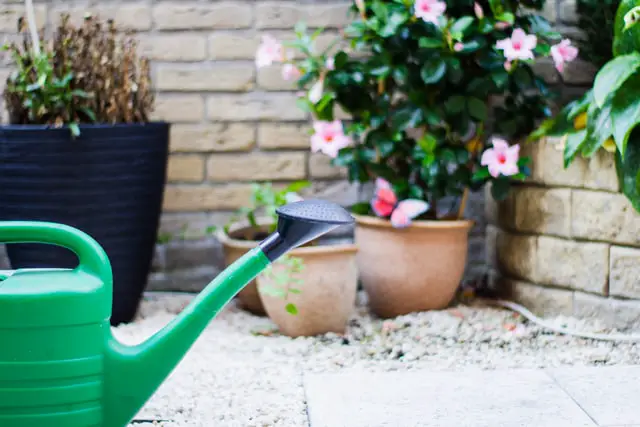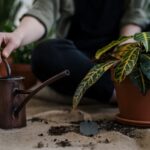Overwatering plants is a common mistake that every person who owns at least one plant has made at some point. Finding the sweet spot between overwatering, underwatering, and correctly watering your plants may be a challenge. Finding the appropriate balance can be challenging.
I have been responsible for the deaths of a few plants by improperly watering them. You will be relieved to know that there are a few simple guidelines you can adhere to in order to guarantee that your plants will always receive the optimal amount of water.
I’ve decided to divide these tips into two distinct groups due to the fact that not all plants will respond to these strategies in the same manner. These two classes are as follows:
- How to prevent overwatering soil-grown plants
- How to Prevent Overwatering of Leca Plants
Plants that are growing in soil make up the first group, while plants that are grown in baked clay balls, also known as Leca, make up the second category. Because I find it much simpler to provide the appropriate amount of water to my plants when they are grown in leca, I have begun the process of transferring my plants from soil to leca. However, I am also going to include plants that are grown in soil because growing plants in soil is still an extremely effective method.
Let’s cut to the chase and get down to business so you can go back to caring for your houseplants in the best way possible.
Table of Contents
How to prevent overwatering soil-grown plants
Due to the fact that there is such a wide variety of soil types, working with soil may be a challenging endeavor. You need to be aware of the water requirements of your plants before you can choose an appropriate soil for them. Do they prefer to be in moist soil all of the time or dry soil for most of the time? Unfortunately, if you do not provide your plant with the moisture levels it requires, you may wind up killing it.
Consider this as an illustrative example:
Take, for instance, a Zebrina alocasia as our example plant. The humidity is perfect for this plant, as it allows it to grow to its full potential. So the plant always prefers soil that is somewhat damp, right? Sadly, you are completely incorrect! The plant has large, long, and attractive stems, and each of these stems may store a significant amount of moisture for use by the plant at a later time.
The Alocasia Zebrina favors dry soil because it saves the water it needs and does not rely on the earth to give it moisture. So, why is this significant? Well, it demonstrates the need to conduct preliminary studies when working with soil.
Find the correct soil, and you’ve done half the effort.
It is time to begin watering your plant once you have determined the type of soil that will either hold or drain the appropriate amount of water for your plant. When you water too much, most of the problems come from giving the soil more water than it can absorb. Root rot might occur if there is any water left behind in the pot.
The trick is to have drainage holes.
Investing in containers that have holes in the bottom to allow excess water to escape is a quick and easy way to solve the problem of having a water pool at the base of your plant. When you water your plants now, the soil absorbs all of the water required to keep the plant alive, and any surplus water drains out the bottom. Because there won’t be any surplus water lingering at the bottom of your container any more, the likelihood of you overwatering your plants has decreased significantly.
Sometimes your favorite pot does not have any drainage holes, but this does not imply that you can no longer use it for your plants. You may either plant your plants in the plastic pot that they came in, which has drainage holes, or you can place the plastic pot that your plants came in inside of the pot that you choose to use, which does not have drainage holes.
In this manner, whenever you need to water your plants, you can just place them in your sink and water them. After around five minutes, all of the extra water will have drained, and you will be able to place your plant together with the plastic pot back into the good looking pot.
The idea here is to allow your plants to drain excess water after watering them. If you choose the appropriate soil for your plant, the soil will be able to hold all of the water that your plant needs.
How to Prevent Overwatering of Leca Plants?
When it comes to correctly watering your plants, growing them in leca rather than soil will make your task much easier. Before I go into how you may avoid overwatering your plants in leca, I’d like to define leca for those who are unfamiliar with the term.
Leca are the balls made of clay that are brown in color and may frequently be found in public places and businesses. These will serve as the medium for plant growth rather than soil. This is due to a number of factors, including the following:
- No soil, no mess
- Simpler to maintain
- Watering is easy
- There is a lower probability of having pests.
Planting your plants in Leca
Assuming you are familiar with what Leca is, the next step is to learn how to cultivate plants inside of these clay balls. After you have obtained the balls and are prepared to place a plant inside of each of them, check to see that the plant’s roots are totally free of any soil. Because the soil will produce a mess and has the potential to cause root rot, you will need to clean the roots of your plant very carefully.
It is necessary to give the leca balls a thorough washing with water in order to remove the clay dust from them.
When you are through cleaning the balls, you will need to let them sit in the water for a while. Although the majority of publications recommend doing this for at least a day, I have never done it in my own life and haven’t experienced any problems as a result.
It is recommended that you place your plant together with the Leca in the plastic pot that your plant most likely came with. This will make it easier to drain any excess water. This indicates that the plastic pot will also need to be cleaned so that the soil can be removed from it.
The simplest part of this procedure is getting started once you’ve put your plant in the leca and are ready to water it.
Plant watering in Leca
When watering the plant, the only thing to remember is that the roots should never be left to sit in water. This indicates that you can continue adding water to the container until the level of the water is just below the roots of the plant.
It is recommended that you use a glass jar for this step; pots can also be used. If you choose to use pots, ensure that you pour enough Leca under the roots so that the plant is lifted off the bottom of the pot. It is difficult to overwater plants since the water never comes into contact with the roots of the plant.
The clay balls hold a small amount of water, but not much, so they will allow the roots to suck on the water. Your plant’s roots will take in the water that has been absorbed by the leca, which is located at the bottom of the container. In the event that your plant needs additional water, it will extend its roots toward the water so that it may drink straight from it.
It doesn’t matter how much or how little water your plants need; Leca will take care of them all. The clay balls maintain a consistent water level, and if the plant determines that this level is insufficient, it will actively seek out additional water on its own.
There is no need to worry about overwatering the spider plant since it will soon consume all of the water you put in the pot. However, as previously said, you may use this method with plants that just need a small amount of water. You may use this method with plants that just need a small amount of water.
Due to the fact that the Sansevieria is only suited for growth in arid conditions, it is essential to ensure that the water level always remains below the plant’s roots. When watering these kinds of plants that are grown in leca, the only thing you need to worry about is maintaining a water level that is below the plant’s roots. The leca will take care of regulating the water level.
Conclusion
There are several ways to avoid overwatering your plants. When you have plants in soil, you must ensure that you acquire the correct soil for your plants. Is the plant happy to spend all of its time in damp soil? Put it in soil that can hold a lot of water.
Does your plant like dry soil? You should look for a soil that swiftly drains most of the water you feed it. This will aid in the correct watering of your plants. It is excellent practice to allow your plants to drain for around five minutes after you have watered them in soil to ensure that no extra water is left behind in the pot. This should be done after watering your plants.
When you use leca, everything gets easier. The only thing you need to watch out for is maintaining a water level that is below the plant’s roots at all times. If you do not allow the roots to become saturated with water, the plant will flourish and thrive.
The spider plant, for example, thrives with a lot of water, so you don’t have to be as concerned about it. If you have a plant like the Sansevieria that thrives best in dry soil, you should take care to prevent the roots from becoming soaked in water, and the Leca will take care of the rest of the responsibilities for you.
I appreciate you taking the time to read my article. I really hope that this information is of use to you in maintaining the health and beauty of your plants.
Photo by Louis Hansel on Unsplash



